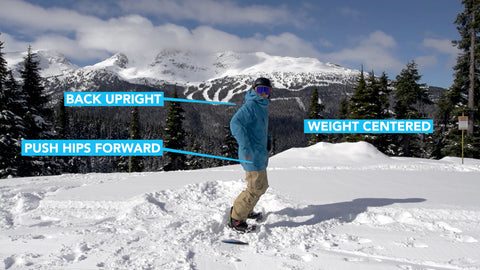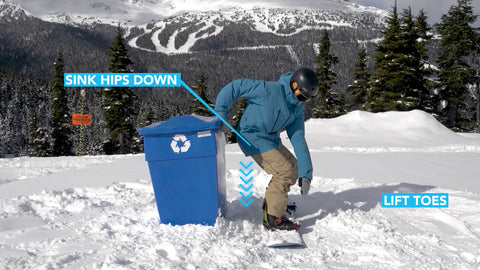
Weight Over The Top Of Your Board
Whether you're having trouble getting through chunky inconsistent snow or you're chattering out on steeper terrain, keeping your weight over the top of your board is going to help get down the hill quicker with fewer falls.
In this tutorial we will teach you the basics of centering your weight over your board and helping your muscles to remember this posture. Check out the full tutorial below or check out our Intermediate Riding series for more great tutorials.
(Narrating/Riding: Nev Lapwood Filming/Edit: Vince Emond. Filmed at Whistler Blackcomb)
Bending Your Knees
A common problem many riders have is riding with their legs too straight or bending over with their upper body. This unstable posture is most visible on heelside turns. Riders tend to hinge at the waist, with their bum stuck out and their upper body leaning forward.

This snowboarder is riding with their legs too stiff leading to an unstable position.
This riding posture centres weight over the edge of the board, which isn't a stable position and can contribute to chattering through and falling in turns.
Ideal Position

The ideal riding position.
In the ideal riding position your weight is centered over your board with your knees in a flexed position, ready to absorb bumps and pop off jumps. To achieve this, flex your shins into the front of your boots, push your hips forward and keep your back upright.
Engage Your Edges
Practice centering your weight over an engaged edge to establish balance and muscle memory. While static on your board, lean onto your heel edge, sinking your hips, back and down, using an object to stablize this exagerated lean. Do the same on your toeside, pushing your hips forward and pressing your shins into the front of your boots.

Engaging your edge in a static position with stabilization.
Now try it while sliding. Traverse across a quiet slope on your toeside, pushing your hips forward and leaning into the front of your boots. Come back across the slope on your heelside pushing your hips back, lifting your toes, and leaning into your highbacks.
Trick Tip: Pay attention on your toeside traverse to the position of your highback. If there's a gap between your boot and the highback, add more forward lean to reduce it. This will help with centering your weight and getting more response out of your board.
Pressuring Your Edges
Applying pressure to your board edge is another key ingredient in reducing chatter and instability in turns. With your weight centered over the top of your board you can practice pressuring turns by gaining speed down a slope then coming to an abrupt heelside stop and hopping up the hill on your heel edge three times.

Snowboarder jumping uphill on his heelside.
Repeat this on your toeside edge by hopping down the hill on your toe edge three times. This exercise helps you learn how to build and release pressure quickly on the edge of your board.
There you are! Remember to flex your knees, lean into your boots, adjust your bindings and get your weight over the top of your board so you stop chattering out and loosing balance on rough terrain.
Want More Riding Tips & Tricks?
Hannah Paquette
Snowboard Addiction
Our Goal Is To Improve Your Riding




